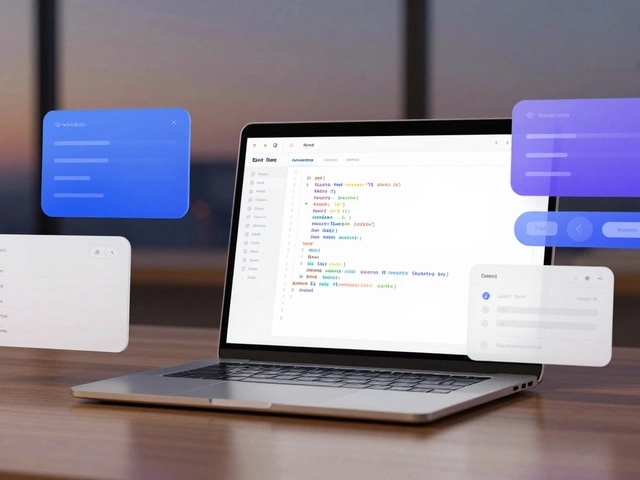Ever wondered if Java is just for back-end tasks? You're not alone. There's this notion floating around that Java is strictly a server-side language, but is that really the case? In reality, while Java isn't the go-to for typical front-end work, it does have its unique places for shining bright on the client side.
Let's get real about this: Java was never designed with the front-end in mind. Its roots have always been deep in the server, powering complex systems with its robust, object-oriented capabilities. But that doesn't mean it can't be leveraged for front-end work under the right circumstances.
For instance, applets were Java's way of dancing on the front-end stage for a while, injecting some oomph into web pages back when it was revolutionary to have moving parts on your browser. Though applets are more of a historical piece today, Java's flexibility means you can still find scenarios, like certain Android applications, where it can sway front-end elements. So, what does this mean for someone who's diving into web development today? Is Java worth the investment for front-end gigs, or are there better tools to reach for? Stay tuned, and let's break it down further.
- Java in Front-End: Myth or Reality?
- The Realms of Java: Beyond Front-End
- When to Use Java for Front-End Tasks
- Alternatives and Java's Future in Web Development
Java in Front-End: Myth or Reality?
When people hear Java, they often picture hefty back-end systems, but it wasn’t always secluded to just server-side. Historically, Java attempted to crack the front-end scene with Java Applets, a tool designed to add interactive features to web pages. However, Applets required plug-ins and had compatibility issues, leading to their eventual fadeout.
Java still finds relevance in the client-side world, especially within Android applications, where it juggles both UI and backend processes. The communities around Android often use Java for developing apps that blend front-end design with back-end functions.
JavaFX: The Modern Take
JavaFX was introduced as a more viable option for building rich client-side applications. This platform allows developers to create desktop apps with seamless GUI, leveraging Java’s strong language features but offering more modern aesthetics than the traditional Swing library.
- JavaFX supports advanced graphics and media features, making it more suited for front-end applications on desktops.
- It utilizes FXML, an XML-based language, for designing user interfaces with a more declarative approach.
A point to note is that while you can tech up a front-end with JavaFX, it’s still primarily utilized for desktop rather than web which remains ruled by HTML, CSS, and JavaScript.
Why Java Isn't the Usual Front-End Pick
There are a few reasons why Java isn’t the first thing developers reach for when tackling web user interfaces:
- JavaScript, along with HTML and CSS, has become the trio of choice for web front-end development due to its ease and browser-native support.
- React, Angular, and Vue.js have set the standards high for interactive web apps, making it harder for Java to compete in this space.
So yes, calling Java a front-end tool might be a bit of a stretch, especially with all the shiny new web techs out there. Yet, it isn't wholly fictional; it’s more a rarity than a standard. The main takeaway? Use Java where its strengths lie, but stay flexible to pick the right tool for the job.
The Realms of Java: Beyond Front-End
Alright, let's take a step back from the front lines of the browser and explore where Java truly flexes its muscles. If we're talking about the bigger picture, Java is a giant in the world of back-end development. It's like the Swiss army knife of programming languages — versatile and incredibly powerful when it comes to handling complex systems.
Java in Enterprise Applications
Think about all the big enterprise applications out there — Java has been a backbone for many of them. Companies love it because it’s reliable and platform-independent, meaning you can run Java on any machine that supports the Java Virtual Machine (JVM). Banking systems, retail management apps, and large-scale CRM systems often rely on Java’s stability. Fun fact: Did you know that about 90% of Fortune 500 companies use Java-based apps?
Android Development
If you've used an Android phone, you've encountered Java’s handiwork. For a long time, Java was the primary language for Android app development. It's wildly popular among developers because it allows writing code once and running it across different types of Android devices with minimal tweaks. While Kotlin is getting more traction nowadays, Java is still very much in the game.
Cloud and Big Data
In the cloud space and big data world, Java's robustness is indispensable. Platforms like Apache Hadoop and Apache Kafka for processing large data sets are all about Java. Its ability to manage and process vast amounts of data without breaking a sweat makes it a favorite both for big data crunching and cloud ecosystems.
Databases
Don't sleep on its role in database management either. Java Database Connectivity (JDBC) is a key player in connecting Java applications with databases. Whether you’re working with SQL or NoSQL databases, Java has the frameworks and libraries to get you connected and up and running efficiently.
All this to say, while Java might not be the star for front-end glitz and glam, it undeniably occupies (and dominates) other essential parts of the tech landscape. Whether it's running complex algorithms or offering mobile solutions, Java's influence runs deep in places where reliability and scalability are non-negotiable.

When to Use Java for Front-End Tasks
So, when should you actually roll out Java for front-end work? First off, if you're diving into Android app development, you'll find Java is almost unavoidable. Android relies heavily on Java, even though Kotlin is gaining ground. This makes Java fundamental for creating user interfaces and handling user interactions on Android devices.
Another scenario might be in enterprises that have a legacy system built entirely in Java. Here, consistency often trumps everything else, so using Java for any necessary front-end interface through frameworks like JavaFX can offer smooth integration with existing systems.
JavaFX: Bringing UIs to Life
JavaFX is a powerful tool within the Java ecosystem that's designed specifically for building rich internet applications. It's perfect when you need to create graphical user interfaces (GUIs) that require intricate design and interactivity, such as data visualization and complex form inputs.
Embedded Device Development
Java is a top pick for projects involving embedded devices and Internet-of-Things (IoT) applications. In these cases, having the same language on both the back-end and any user-facing parts can simplify development and maintenance. Java's ability to scale efficiently is another big plus here.
While web development isn't Java's strongest suit, it's worth considering in niche cases where you're already using Java for business logic or need tight integration with vast Java ecosystems. If you're in a mixed-language environment or developing with heavy back-end needs, it could also simplify workflows by using a unified language approach.
Considerations and Trade-offs
- Performance: Java's virtual machine overhead can slow things down, which might not be ideal for front-end requirements demanding quick responsiveness.
- Compatibility: While Java is great for apps and GUIs, for regular web pages, JavaScript or frameworks like React are generally more suitable.
At the end of the day, choosing Java for the front-end hinges on unique project needs more than anything else. Weigh these factors carefully to decide if it's the right match for your goals.
Alternatives and Java's Future in Web Development
When we talk about alternatives for Java in the web development world, several languages and frameworks come to mind that are quite popular on the front end. Languages like JavaScript, HTML, and CSS have long dominated this space, and for good reason. They're designed specifically to handle the distinctive needs of web interfaces, with extensive ecosystems of frameworks and libraries.
JavaScript is obviously the king of front-end development, with frameworks like React, Angular, and Vue.js. These tools make building interactive user interfaces a breeze and have tons of community support. Every year, new tools, libraries, and software make front-end development even more accessible and powerful.
Why Java Stays in the Game
So, given all these alternatives, where does Java fit in? While Java might not be the go-to for traditional front-end tasks anymore, it’s not losing relevance anytime soon. Its ability to handle complex business logic and secure transactions with ease keeps it a favorite in building robust backend services. Moreover, its versatility and object-oriented nature make it a solid choice for certain applications where back-end and front-end overlap, especially in enterprise applications.
Emerging Trends
Looking to the future, there's talk about how Java might carve out a niche for itself on the front-end too. Technologies like GraalVM are pushing boundaries, allowing Java to run alongside, and even compete with, JavaScript and Python's ecosystems. There's potential for Java to make a comeback in new areas of the web.
Data-Driven Insights
According to a recent developer survey, while Java's usage in front-end development remains limited, it's still used by about 10% of full-stack developers, primarily those dealing with complex interface logic or Android development.
| Technologies | Use Case |
|---|---|
| JavaScript | Interactive User Interfaces |
| Java | Robust Back-End & Overlap Areas |
| GraalVM | Expanding Java Integration with other Front-End Technologies |
Ultimately, if you're knee-deep in the web development scene, you need to keep an eye on these evolving technologies. Java may not lead the front-end charge, but its future in web development is far from obsolete. Pioneers are always looking for ways to leverage stable, mature technologies to create pioneering solutions. Who knows? Java's next big thing might be just around the corner.





